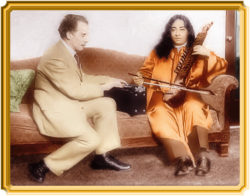
Durga Mata was one of the main chanters among Yogananda’s disciples. The Master told her that chanting was her lifelong dharma: “Your path is individual teaching and through chanting.”
You may acquire a recording of her chants here.
In her book Trilogy of Divine Love, she describes her inner voyage through chanting Yogananda’s Cosmic Chants. It began right at the beginning, when she first met the Guru: a Cosmic Chant was central.
“My first sight of Guruji was on December 19, 1927. We sat spellbound gazing upon the most beautiful man I had ever seen, in his orange robe and long black flowing hair on his shoulders, and his large lotus, dark, expressive eyes. He was playing on his harmonium, ‘Oh God Beautiful.’ I had never heard chanting before and it fascinated me to the very core of my soul (This very harmonium Master gave me in 1932). I had never heard God expressed in this light before. I was used to thinking of God as Jesus and without hope of ever reaching Him. Although I was Catholic and heard about Jesus as the only Savior, I never did have very much devotion towards Him. This chant deeply appealed to me and gave me a different light on a tangible God.”
As a neophyte at Yogananda’s ashram, Mount Washington, she soon experienced the magic results of chanting the Cosmic Chants: “When one calls God earnestly with deep feeling, God will manifest himself in the blessed form of the Guru. Another time I was preparing the vegetables for the banquet: standing over the sink, I was chanting ‘Door of My Heart.’ I had just repeated the words, ‘Wilt Thou come, just for once come to me,’ when I felt Master standing by my side, saying, ‘I have come.’ I was so new here that only my soul recognized the depth of his sacred words.”
Yogananda specifically trained Durga Mata in chanting the Cosmic Chants: “Master had trained me to play the cymbals, while he played the harmonium, sometimes his big drum. When it came time for Master to play his chant, he told me to give the cymbals to Tony [Diegel]. Then, without hesitation, Master picked up the big drum and placed it in my lap, saying, ‘Here, you play this.’ I was never so dumbfounded: he played ‘Oh God Beautiful’ in Bengali and I played that drum as if I had played it all my life. Much later, he told me that I played the drum in my previous Indian incarnation in his hermitage. No wonder it came to me naturally. Thereafter, until Master’s mahasamadhi, at all of Master’s sankirtans and meditations, I played the drum. And if he wanted to play the drum or the cymbals, I played the harmonium, for I could play it to satisfy his tempo. He played them so very well, it made our playing sound, no doubt, amateurish to him.”
Chanting together with Yogananda was definitely a highlight of her spiritual life: “When he prayed, the magnetism of his words penetrated our minds, and when he played on the harmonium and chanted, he pulled our hearts along with him to deeper depths.”
Such devotional chanting happened regularly, both in the morning and evening, as Durga Mata recalls:
“Master used to call us to his library for our morning meditations and sankirtan; we all sat on the floor.”… “Master loved to play the small foot pump organ we had. In the evening, we used to gather around Master at the organ and chant to our hearts’ content. When he bought the large pipe organ, he used to play it late at night, long; and the louder, the more he enjoyed it.”
Attunement with the guru
Here is an essential teaching he gave to Durga Mata, and through her to all of us, on inner attunement during chanting: “’Though Schramm was a music protégé since childhood, she cannot play one of my chants, because she did not have notes. She would have played them perfectly if there were notes, but it would not come from her heart. I want you to chant from your heart, mind, and what comes natural to you from me.”
We too, then, when we chant, should try to sing from the heart, in a way that “comes naturally” to us from him.
